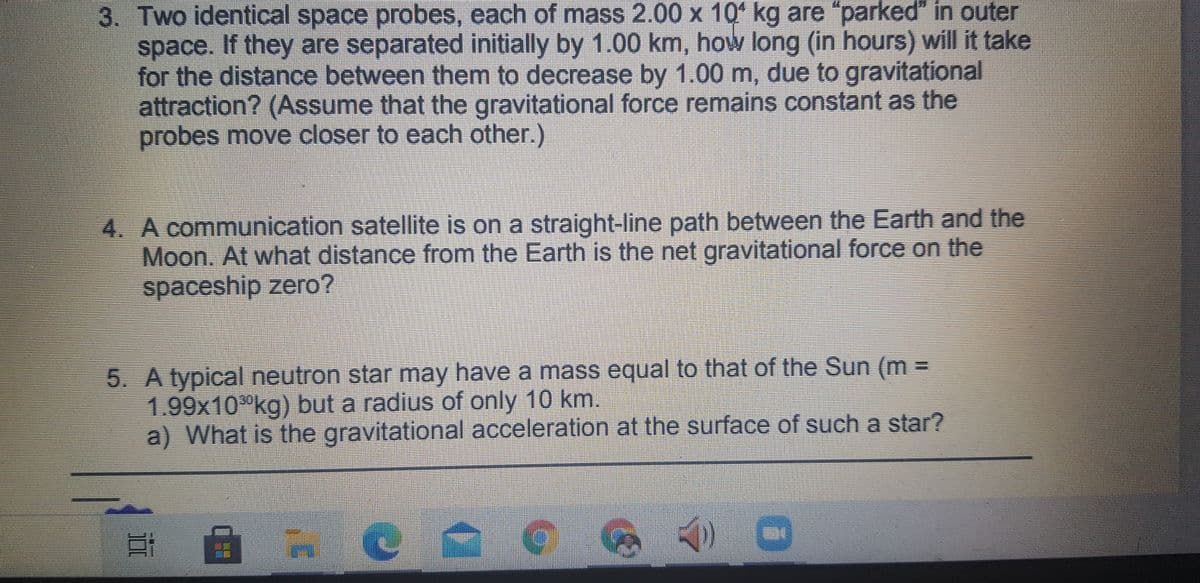3. Two identical space probes, each of mass 2.00 x 1Qʻ kg are "parked" in outer space. If they are separated initially by 1.00 km, how long (in hours) will it take for the distance between them to decrease by 1.00 m, due to gravitational attraction? (Assume that the gravitational force remains constant as the probes move closer to each other.)
3. Two identical space probes, each of mass 2.00 x 1Qʻ kg are "parked" in outer space. If they are separated initially by 1.00 km, how long (in hours) will it take for the distance between them to decrease by 1.00 m, due to gravitational attraction? (Assume that the gravitational force remains constant as the probes move closer to each other.)
Physics for Scientists and Engineers: Foundations and Connections
1st Edition
ISBN:9781133939146
Author:Katz, Debora M.
Publisher:Katz, Debora M.
Chapter11: Collisions
Section11.5: One-dimensional Elastic Collisions
Problem 11.5CE: If a spacecraft is headed for the outer solar system, it may require several gravitational...
Related questions
Question

Transcribed Image Text:3. Two identical space probes, each of mass 2.00 x 10ʻ kg are "parked" in outer
space. If they are separated initially by 1.00 km, how long (in hours) will it take
for the distance between them to decrease by 1.00 m, due to gravitational
attraction? (Assume that the gravitational force remains constant as the
probes move closer to each other.)
4. A communication satellite is on a straight-line path between the Earth and the
Moon. At what distance from the Earth is the net gravitational force on the
spaceship zero?
5. A typical neutron star may have a mass equal to that of the Sun (m =
1.99x10°kg) but a radius of only 10 km.
a) What is the gravitational acceleration at the surface of such a star?
Expert Solution
This question has been solved!
Explore an expertly crafted, step-by-step solution for a thorough understanding of key concepts.
This is a popular solution!
Trending now
This is a popular solution!
Step by step
Solved in 2 steps with 2 images

Knowledge Booster
Learn more about
Need a deep-dive on the concept behind this application? Look no further. Learn more about this topic, physics and related others by exploring similar questions and additional content below.Recommended textbooks for you

Physics for Scientists and Engineers: Foundations…
Physics
ISBN:
9781133939146
Author:
Katz, Debora M.
Publisher:
Cengage Learning

Principles of Physics: A Calculus-Based Text
Physics
ISBN:
9781133104261
Author:
Raymond A. Serway, John W. Jewett
Publisher:
Cengage Learning

College Physics
Physics
ISBN:
9781938168000
Author:
Paul Peter Urone, Roger Hinrichs
Publisher:
OpenStax College

Physics for Scientists and Engineers: Foundations…
Physics
ISBN:
9781133939146
Author:
Katz, Debora M.
Publisher:
Cengage Learning

Principles of Physics: A Calculus-Based Text
Physics
ISBN:
9781133104261
Author:
Raymond A. Serway, John W. Jewett
Publisher:
Cengage Learning

College Physics
Physics
ISBN:
9781938168000
Author:
Paul Peter Urone, Roger Hinrichs
Publisher:
OpenStax College

Glencoe Physics: Principles and Problems, Student…
Physics
ISBN:
9780078807213
Author:
Paul W. Zitzewitz
Publisher:
Glencoe/McGraw-Hill

Physics for Scientists and Engineers, Technology …
Physics
ISBN:
9781305116399
Author:
Raymond A. Serway, John W. Jewett
Publisher:
Cengage Learning

Astronomy
Physics
ISBN:
9781938168284
Author:
Andrew Fraknoi; David Morrison; Sidney C. Wolff
Publisher:
OpenStax